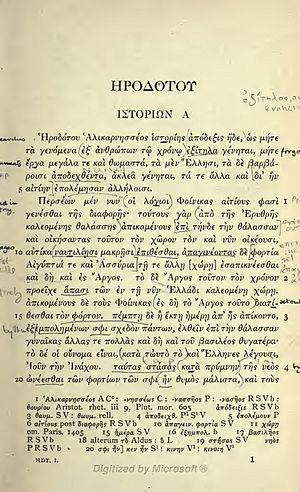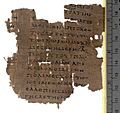Histories (Herodotus) facts for kids
 |
|
| Author | Herodotus |
|---|---|
| Country | Greece |
| Language | Ancient Greek |
| Genre | History |
| Publisher | Various |
|
Publication date
|
c.440 BCE |
The Histories is a super important book written by a Greek guy named Herodotus. He lived around 440 BC. Many people think this book is the very first real history book ever written in the Western world! It tells the amazing story of the Greco-Persian Wars. These were big fights between the powerful Achaemenid Empire (Persians) and the many Greek city-states in the 5th century BC.
Contents
The Histories: The First History Book
The Histories is a famous book written by Herodotus. He was from a place called Halicarnassus in ancient Greece. This book is special because it tries to explain why events happened. It doesn't just list facts. Herodotus traveled a lot to gather his information. He talked to many people and wrote down what he learned.
Who Was Herodotus?
Herodotus is often called the "Father of History." He was born around 484 BC. He lived during a time when Greece was very active. He loved to explore and learn about different cultures. He visited places like Egypt, Persia, and many Greek cities. He wanted to understand the world around him.
Herodotus wrote down stories and facts. He also included myths and legends. He tried to be fair to both sides in the wars he described. He wanted to show different points of view.
What's Inside The Histories?
The Histories is divided into nine books. Each book covers different topics. It starts by talking about the rise of the Persian Empire. It then tells about the customs and traditions of many different peoples. These include the Egyptians, Scythians, and Lydians.
Herodotus describes their ways of life. He talks about their religions, their food, and how they fought. He even tells some really interesting stories. For example, he wrote about giant ants that dug for gold! He also described how the Nile crocodile gets its teeth cleaned by a bird.
Stories of Ancient Lands
Book 1 of The Histories tells about the Lydian king Croesus. He was very rich. It also talks about the powerful Persian king Cyrus the Great. Herodotus describes the customs of the Babylonians. He even mentions a "marriage market" where men would buy wives.
Later books focus more on the wars. They describe the battles and the leaders involved. Herodotus wanted to explain the causes of the conflict. He looked at events from many years before the actual fighting began.
The Greco-Persian Wars
A big part of The Histories is about the wars between Greece and Persia. These wars lasted for many years. The Persian Empire was huge and very strong. The Greek city-states were smaller. But they were determined to stay free.
Key Battles and Heroes
Herodotus describes important battles in detail. One famous battle was the Battle of Marathon. The Greeks won a surprising victory there. Another big fight was the Battle of Thermopylae. A small group of brave Spartans fought a huge Persian army. They held them off for a long time.
He also writes about the Battle of Salamis. This was a huge naval battle. The Greek ships, called triremes, defeated the Persian fleet. These stories show the bravery and cleverness of the Greek leaders. People like Miltiades and Themistocles became heroes.
Why Is It Important Today?
The Histories is important for many reasons. It gives us a look into the ancient world. It helps us understand how people lived and thought. It also shows us how history was first written down.
Herodotus's work set the standard for future historians. He tried to find out the truth. He also tried to explain why things happened. His book is still read and studied by people all over the world. It teaches us about courage, freedom, and the clash of cultures.
Images for kids
-
Edwin Long's 1875 interpretation of The Babylonian Marriage Market as described by Herodotus in Book 1 of the Histories
-
Nile crocodile allowing the trochilus to eat leeches in its mouth. Drawing by Henry Scherren, 1906
-
Scythian warriors, drawn after figures on an electrum cup from the Kul'Oba kurgan burial near Kerch (Hermitage Museum, Saint Petersburg)
-
Relief of Darius I, a Persian king, at Persepolis
-
Statue of Athena, the patron goddess of Athens
-
A Greek trireme warship
-
Miltiades, a famous Athenian general
-
The Battle of Salamis, a huge naval battle, painted by Wilhelm von Kaulbach (1868)
-
The Serpent Column dedicated by the victorious Greeks in Delphi, later moved to Constantinople
-
The Himalayan marmot, possibly the "gold-digging ant" Herodotus described
See also
 In Spanish: Historias (Heródoto) para niños
In Spanish: Historias (Heródoto) para niños















